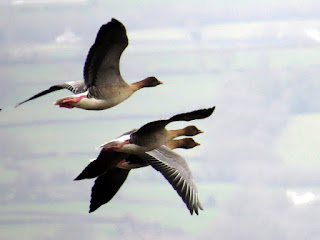Today I paid another visit to the
Dee Estuary. Not this time majoring on the RSPB Burton Mere reserve but to the Parkgate area. A few words of explanation. Parkgate used to be a resort on the Dee Estuary. However over the years the salt marsh has encroached and the River Dee and the estuary mud used by the goose, ducks and waders are far away. A few times each month at high Spring tides much of the salt marsh is covered and birds come closer and closer before being flushed off to a few inaccessible high tide roosts.
The 11th was one such day – February is the last month when the geese will remain in high numbers. The remains of Storm Ciara ensured that low pressure remained to boost the height of the tide. The RSPB set up a stall at the boathouse at the far end of the ‘sea front’. Today was so windy that the best option was to stay in the car parked along the front or hide behind it to get shelter from the wind. It was rather dull weather. With all that proviso here we go with some of images I caught.
The dominant winter visiting goose is the Pink-footed Goose. Here a group heads off to roost. The background is Wales on the opposite side of the River Dee. The pale forewing is not as prominent as on the slightly larger Greylag Goose. Greylag is more easily separated by its large orange bill.
A few pass closer. See they do have pink feet, though it is hardly the most obvious feature most of the time.
Nowhere can escape the Canada Geese. An adult Lesser Black-backed Gull at bottom left.
The area is a good place to see the attractive Pintail. Here a pair pass by. The drake’s plumage is unmistakable. The duck shares the obvious this neck.
Little Egrets are abundant here and come close whatever the tide. This one shows many breeding ‘aigrettes’ – lengthened feathers on the back and the breast: the blue at the base of the bill will soon go reddish.
In flight the ‘yellow’ feet are very obvious. They look slightly pink-tinged to me.
This one has a caught what seems to be a rat! It too has pink-tinged feet.
It has ‘grounded’ its prey to get to grips with it.
A ‘bad hair day’ for this Little Egret.
Back at the main RSPB Reserve to warm up this group of two Great White and two Little Egrets were positioned to provide a good size comparison. Yellow bill on the Great White and black on the Little.
No mistaking the long curved bill of Curlew.
The most abundant wader in winter is Black-tailed Godwit. In flight it is the bold wing pattern that it most obvious rather than the ‘black tail’. A large wader with a long straight red-based bill.
This group has been joined by a lone Lapwing and adult Black-headed Gull.
Another large group also with a Lapwing – the bottom bird. Only when I looked at this photo did I notice that there is a Knot among them – towards the bottom left. Small, shorter bill and less well-marked wings and tail.
This closer group shows the characteristic was the feet on this long-legged species stick out beyond the tail in flight.
Second most-common wader was Redshank. A group performing nicely showing their unique wing pattern, medium-length bill and red ‘shanks’ – legs. Not too the barred tail.
Quite common actually!
Not quite sharp but worth noting some of the distinctive features of this winter Common Gull. The small yellow-green bill with a dark necklace is very typical. So too is the extensive white in the wing-tip – more than on any age Herring Gull. The tone of the back and wings is also slightly darker than Herring Gull. Unusual is the dark marks on the primary coverts indicating this is a second-year bird. Note too the dark eye – at all ages in this species.
A passing Lesser Black-backed Gull. Probably a third-winter bird as there is much black on the bill, the wing-tips lack any white ‘mirrors’ and the tail shows a few dark markings.
It is not all geese, ducks and waders. Many Skylarks and Meadow Pipits hide in the salt marsh and gradually come closer. Here two Skylarks. The short crest is just about visible here. One distinctive marking is the rather rounded, pale-fringed greater coverts.
In flight Skylarks have a very distinctive silhouette. Note the white outer tail-feathers and the thin white trailing edge to the wings.
And here a Meadow Pipit. A longer, thinner bill on this species which matches the Sky Lark in tone.
(Ed Wilson)





















